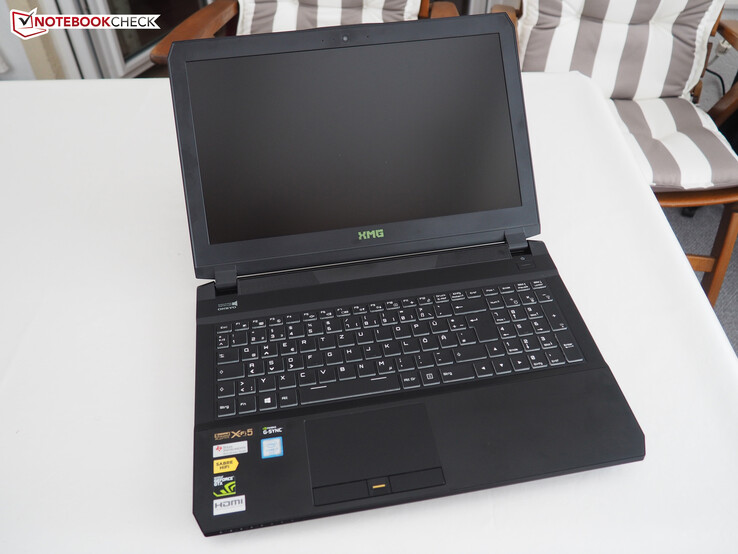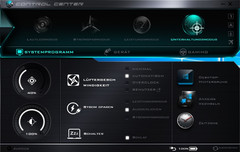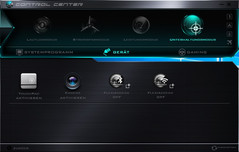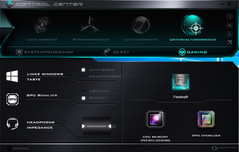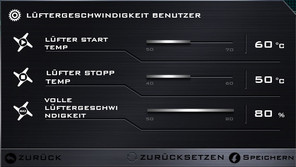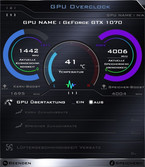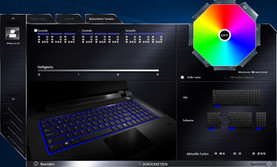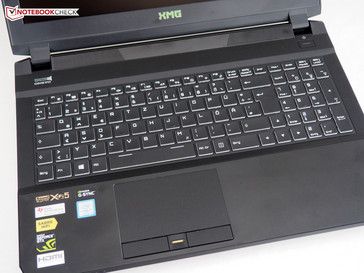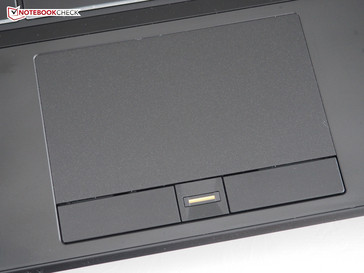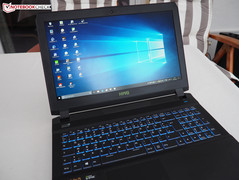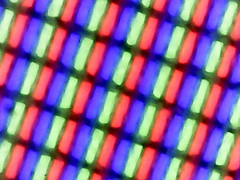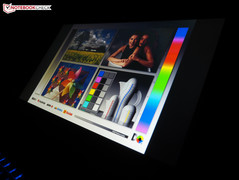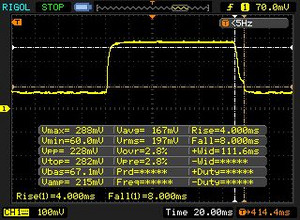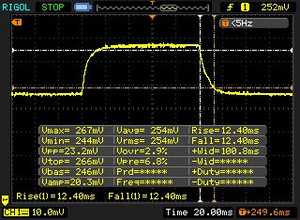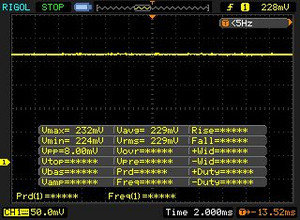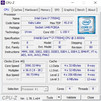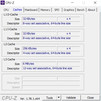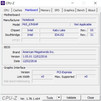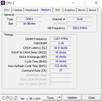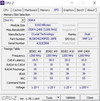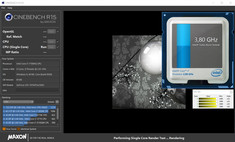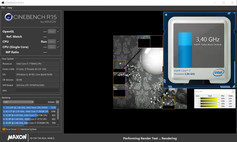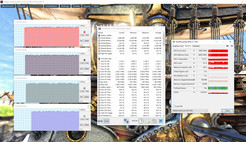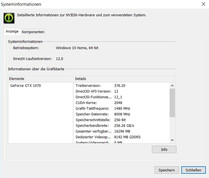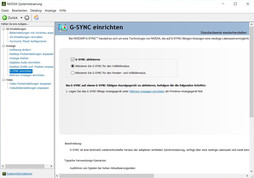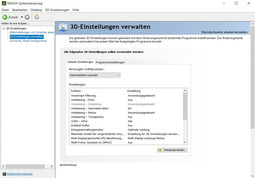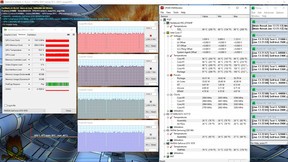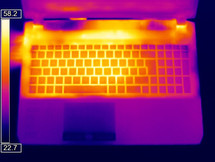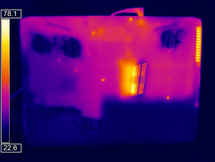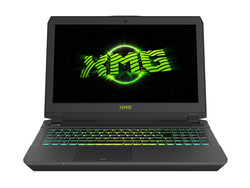Schenker XMG P507 (Clevo P651HS-G) Notebook Review
For the original German review, see here.
Schenker Technologies focuses on Intel’s brand-new Kaby Lake processor generation for the 2017 model of the compact 15-inch gaming system XMG P507. Instead of a Core i7-6700HQ (Skylake architecture), we now get the slightly higher-clocked quad-core models Core i7-7700HQ and Core i7-7820HK.
Once again, the graphics card is a high-end chip from Nvidia. As well as the GeForce GTX 1060, you can also get the much more powerful, albeit more expensive GeForce GTX 1070 configuration. Nvidia’s G-Sync technology is also included, which can be expected for a modern gaming notebook. This, combined with the 120 Hz panel means that the XMG P507 promises buttery-smooth pictures. The system is available with up to 64 GB DDR4 RAM and up to four storage solutions. There are also numerous options for the wireless module, the keyboard language, and the operating system. However, as with other competitors, an optical drive is not available.
The XMG P507 starts at 1499 Euros (~$1611), but a model with Windows 10, PCIe/NVMe-SSD and at least 16 GB of RAM can easily cost over 2000 Euros (~$2150). Our test model is even more expensive and retails for 2400 Euros (~$2579).
Case
The case of the 15-inch model will vary depending on the graphics card. While the chassis of the GTX 1060 model is 2.5 cm (~1 in) high, the GTX 1070 version measures 2.9 cm (~1.1 in), which is still pretty slim for a gaming device. The weight is also decent at 2.9 kg (~6.4 lb); other 15-inch devices such as the Acer Predator 15 are much heavier. Therefore, we have selected only such competitors that weigh less than 3.0 kg (~6.6 lb). The list includes the previous models from 2016, the MSI notebooks GT62VR and GS63VR as well as the Asus GL502VS.
The quality of the XMG P507 leaves a good impression. Except for the plastic bottom panel of the GTX 1070 edition, most of the case is made of metal. It is elegant and nice to touch, but the dark color scheme is susceptible to dirt (fingerprints, etc.).
The stability is also pretty good thanks to a metal inlay. Apart from the not so rigid lid, even strong pressure is not a big problem for the XMG P507. The good build quality supports the positive impression. All the gaps and transitions on our test model were even. Once again, we have to criticize the lid construction, which creates a lot of clouding/backlight bleeding independent of the display model (there seems to be too much or uneven pressure).
Otherwise, there is not much to criticize. We like the pretty simple design. It has dispensed with the red elements and is therefore a nice contrast to other systems, where the target audience is between 10 to16 years.
Connectivity
Ports
At a first glance, you cannot see many differences when you compare the XMG P507 with the previous model. The changes are pretty small, and the best example is the new port layout. Barebones manufacturer Clevo has relocated the USB 3.1 Type-C port from the right to the left side of the chassis, and the same applies to the USB 3.0 port at the back. On the other hand, the HDMI 2.0 port (4K @60Hz) and one of the two Mini-DisplayPorts have been moved to the rear, which is also a welcome change.
Nothing has changed in terms of the three audio ports (headphones, microphone, line-out), the SIM-card slot (optional UMTS/LTE module), the card reader, the Gigabit Ethernet module, and the slot for a Kensington Lock. Unfortunately, the XMG P507 does not support Thunderbolt 3, which should be standard for a gaming notebook in 2017, especially since the GPU is soldered and external solutions will become more interesting in a couple of years.
SD Card Reader
The integrated card reader supports the standards MMC, RSMMC, SD, miniSD, SDHC as well as SDXC and manages average transfer rates. Around 88 MB/s for sequential reads and 78 MB/s for the transfer of .jpg pictures are on par with the Asus GL502VS. The MSI GT62VR (140 to 190 MB/s) is much faster, while the MSI GS63VR (26 to 28 MB/s) is at the bottom of the ranking.
| SD Card Reader | |
| average JPG Copy Test (av. of 3 runs) | |
| MSI GT62VR-6RE16H21 | |
| Schenker XMG P507 PRO | |
| Schenker XMG P507 | |
| Asus Strix GL502VS-FY032T | |
| MSI GS63VR-6RF16H22 Stealth Pro | |
| maximum AS SSD Seq Read Test (1GB) | |
| MSI GT62VR-6RE16H21 | |
| Schenker XMG P507 PRO | |
| Schenker XMG P507 | |
| Asus Strix GL502VS-FY032T | |
| MSI GS63VR-6RF16H22 Stealth Pro | |
Communication
Wireless communications are handled by an Intel product. The Wireless-AC8265 manages pretty good results in the XMG P507. Our standardized WLAN test (one meter/~3ft between the laptop and the router) determined between 513 and 674 Mbps. This is not surprising since Intel advertises a maximum of 867 Mbps (5 GHz support) on its homepage. It is also possible to use the RJ45 jack when you do not want to rely on a wireless connection during online gaming. The corresponding network controller is provided by Realtek.
| Networking | |
| iperf3 transmit AX12 | |
| Schenker XMG P507 PRO | |
| iperf3 receive AX12 | |
| Schenker XMG P507 PRO | |
Security
The security aspect is not completely ignored either. As well as a fingerprint scanner, which sits between the mouse buttons, the XMG P507 is also equipped with a TPM 2.0 chip.
Accessories
Schenker ships the device with a cleaning cloth, a drivers DVD, a multi-language manual as well as an XMG sticker. There are also four small screws for a secondary HDD. The size and the output of the PSU will depend on the graphics card (200 watts @GTX 1060, 230 watts @GTX 1070). Great: You will get a recovery DVD when you order an operating system.
Maintenance
Once you have loosened 14 screws (two of them secure the keyboard), you can lift the entire bottom panel. However, you will have to use some force as the panel is secured very tightly. We recommend starting at the indentation of the Ethernet jack. Once this is done, you can access all the components (similar to the previous model). This includes the screwed battery, storage and memory, the wireless module or the cooling system, which consist of three fans and six heat pipes. Both the CPU and GPU are soldered, so you cannot upgrade them. By the way: The keyboard has to be removed when you want to access RAM slots #3 and #4.
Warranty
The basic warranty is 24 months. 36 months are possible via an upgrade, as well as the optional system check-up and an extension of the quick repair.
Please see our Guarantees, Return Policies & Warranties FAQ for country-specific information.
Software
Schenker is very restrained in terms of software and – unlike many rivals – does not install any bloat ware. The most important features can be easily controlled via Control Center (see screenshots). Not only is the manual fan control an advantage, there is also a GPU button to switch between the G-Sync and Optimus technology. The latter can increase the battery runtimes significantly, so you should use “MSHybrid” instead of “Separate” on the road. Tuning and styling fans will be happy with “GPU Overlock” and “Flexikey” (Macros, adjustment of the illumination).
Input Devices
Keyboard
While the relocation of some ports is more of a visual change, the new keyboard has a much bigger effect in practice. This starts with the typing experience, which appears to be slightly more precise despite similar base qualities (firm feedback, audible typing noise). The RGB illumination has also been tweaked. While the old XMG P507 was limited to just one color, you can now use different colors for the three-zone keyboard of the new chassis. There are also several patterns such as breathing or waves, but they can become quite annoying over time and more of a gimmick.
Another change is the lettering on the keys. Thanks to the removal of red and blue elements (WASD keys, F-row); the keyboard now looks more uniform and sophisticated. Whether you like the futuristic font is a matter of taste. This is also true of the layout: It is quite similar to the standard, but there are still some areas for improvement. The left Shift key, for example, is very narrow. Otherwise, the keys are well-sized – even the directional keys and the numeric keypad.
Touchpad
The touchpad is identical to that of the predecessor as far as we can tell. The surface measures 10.8 x 6.3 cm (~4.25 x ~2.5 in) and sits slightly deeper in the chassis. The precision is decent and the gliding capabilities are pretty good in combination with the smooth finish. Multitouch gestures such as scrolling and zooming also work well. The dedicated mouse buttons, which make drag-and-drop actions much more comfortable compared to ClickPads, do not give cause for a lot of criticism either. It is also possible to deactivate the touchpad (located underneath space bar and AltGr) when you play with an external mouse and want to avoid accidental inputs. Secondary functions such as the volume and brightness control are triggered via Fn combination.
Display
The 120 Hz display with the designation AUO B156HTN05.2 (AUO52D) leaves mixed impressions. Positive aspects include the high luminance (365 nits on average at the highest level) as well as quick response times. 12 ms black-to-white and 24 ms grey-to-grey are very good for a notebook. IPS panels often need twice as much, which could be an issue for core gamers (potential tearing with fast movements).
| |||||||||||||||||||||||||
Brightness Distribution: 85 %
Center on Battery: 357 cd/m²
Contrast: 714:1 (Black: 0.5 cd/m²)
ΔE ColorChecker Calman: 9.93 | ∀{0.5-29.43 Ø4.78}
ΔE Greyscale Calman: 10.32 | ∀{0.09-98 Ø5}
89% sRGB (Argyll 1.6.3 3D)
58% AdobeRGB 1998 (Argyll 1.6.3 3D)
65.1% AdobeRGB 1998 (Argyll 3D)
88.9% sRGB (Argyll 3D)
66.4% Display P3 (Argyll 3D)
Gamma: 2.11
CCT: 10096 K
| Schenker XMG P507 PRO AUO B156HTN05.2 (AUO52ED), 1920x1080 | Schenker XMG P507 LG Philips LP156WF6 (LGD046F), 1920x1080 | MSI GT62VR-6RE16H21 LG Philips LP156WF6 (LGD046F), 1920x1080 | MSI GS63VR-6RF16H22 Stealth Pro Samsung 156HL01-104 (SDC324C) , 1920x1080 | Asus Strix GL502VS-FY032T LG Philips LP156WF6-SPB6 (LGD046F), 1920x1080 | |
|---|---|---|---|---|---|
| Display | -5% | -4% | 6% | -6% | |
| Display P3 Coverage (%) | 66.4 | 64.5 -3% | 64.6 -3% | 67.8 2% | 64.5 -3% |
| sRGB Coverage (%) | 88.9 | 83.4 -6% | 84.6 -5% | 97.4 10% | 83.1 -7% |
| AdobeRGB 1998 Coverage (%) | 65.1 | 61 -6% | 61.8 -5% | 69.7 7% | 60.8 -7% |
| Response Times | -71% | -63% | -117% | -75% | |
| Response Time Grey 50% / Grey 80% * (ms) | 24 ? | 36 ? -50% | 34 ? -42% | 38 ? -58% | |
| Response Time Black / White * (ms) | 12 ? | 23 ? -92% | 22 ? -83% | 26 ? -117% | 23 ? -92% |
| PWM Frequency (Hz) | 202 ? | ||||
| Screen | 17% | 21% | 22% | 18% | |
| Brightness middle (cd/m²) | 357 | 288 -19% | 273 -24% | 293 -18% | 315 -12% |
| Brightness (cd/m²) | 365 | 292 -20% | 278 -24% | 279 -24% | 290 -21% |
| Brightness Distribution (%) | 85 | 87 2% | 88 4% | 84 -1% | 85 0% |
| Black Level * (cd/m²) | 0.5 | 0.3 40% | 0.27 46% | 0.33 34% | 0.32 36% |
| Contrast (:1) | 714 | 960 34% | 1011 42% | 888 24% | 984 38% |
| Colorchecker dE 2000 * | 9.93 | 5.1 49% | 3.67 63% | 3.59 64% | 4.88 51% |
| Colorchecker dE 2000 max. * | 14.87 | 9.44 37% | 8.33 44% | 5.79 61% | 8.88 40% |
| Greyscale dE 2000 * | 10.32 | 4.43 57% | 2.73 74% | 3.86 63% | 4.17 60% |
| Gamma | 2.11 104% | 2.46 89% | 2.49 88% | 2.53 87% | 2.53 87% |
| CCT | 10096 64% | 6687 97% | 7029 92% | 7229 90% | 6683 97% |
| Color Space (Percent of AdobeRGB 1998) (%) | 58 | 55 -5% | 55 -5% | 63 9% | 55 -5% |
| Color Space (Percent of sRGB) (%) | 89 | 83 -7% | 84 -6% | 97 9% | 83 -7% |
| Total Average (Program / Settings) | -20% /
1% | -15% /
5% | -30% /
9% | -21% /
1% |
* ... smaller is better
However, quick response times are not the only advantage of 120 Hz, because the picture appears smoother in general, when you play games – at least as long as the GPU is powerful enough. The color gamut of the XMG P507 is 89% sRGB and 58% AdobeRGB – decent results that should satisfy most users.
All the other measurement results are pretty average in our comparison group. Sadly, we can see a slight gray hue in dark passages due to the high black value (0.5 cd/m²). The contrast ratio cannot really meet the retail price either: Around 714:1 is pretty mediocre in our comparison.
However, the biggest problem is the color accuracy. We can see a distinct blue cast ex-works, but it can be removed by a calibration. The high grayscale and ColorChecker deviations can also be reduced significantly with a calibration (from almost 10 to less than 3, .icc-file is linked).
One thing you cannot change is the limited viewing angle stability, and trained eyes will immediately see the difference compared to an IPS panel. Overall, we are rather disappointed by the picture quality of the TN panel – 120 Hz and good outdoor capabilities or not.
Display Response Times
| ↔ Response Time Black to White | ||
|---|---|---|
| 12 ms ... rise ↗ and fall ↘ combined | ↗ 4 ms rise | |
| ↘ 8 ms fall | ||
| The screen shows good response rates in our tests, but may be too slow for competitive gamers. In comparison, all tested devices range from 0.1 (minimum) to 240 (maximum) ms. » 30 % of all devices are better. This means that the measured response time is better than the average of all tested devices (20.2 ms). | ||
| ↔ Response Time 50% Grey to 80% Grey | ||
| 24 ms ... rise ↗ and fall ↘ combined | ↗ 12 ms rise | |
| ↘ 12 ms fall | ||
| The screen shows good response rates in our tests, but may be too slow for competitive gamers. In comparison, all tested devices range from 0.165 (minimum) to 636 (maximum) ms. » 33 % of all devices are better. This means that the measured response time is better than the average of all tested devices (31.6 ms). | ||
Screen Flickering / PWM (Pulse-Width Modulation)
| Screen flickering / PWM not detected | |||
In comparison: 53 % of all tested devices do not use PWM to dim the display. If PWM was detected, an average of 8101 (minimum: 5 - maximum: 343500) Hz was measured. | |||
Performance
Schenker Technologies has sent us a pretty well-equipped test model. 16 GB DDR4 RAM and a 500 GB PCIe x4 NVMe-SSD increase the base price. The most expensive upgrade, however, is the jump from the GTX 1060 to the GTX 1070, which will set you back by almost 400 Euros (~$430). A CPU upgrade does not make much sense from a gaming perspective, where the GPU is usually the limiting factor.
Processor
The 14nm chip Core i7-7700HQ has the best price-performance ratio and is the most “reasonable” quad-core model from Intel's Kaby Lake generation, despite the locked multiplier. Kaby lake hardly differs from the previous Skylake architecture. Once again, you get 6 MB L3-cache similar to the Core i7-6700HQ, and technologies such as Hyperthreading and Turbo Boost are supported. The TDP is also identical at 45 watts.
Intel has increased the clocks slightly to improve the performance. The Core i7-770HQ now runs at 2.8 to 3.8 GHz under load instead of 2.6 to 3.5 GHz. The XMG P507 utilizes the Turbo range very well. We can see between 3.4 and 3.8 GHz for the Kaby Lake chip in the CPU and GPU benchmarks (depending on the number of active cores).
Thanks to the high clocks, the XMG P507 can beat Skylake notebooks with the Core i7-6700HQ by around 10% (see Cinebench R15 and R11.5). The system can switch automatically between Nvidia GPU and the iGPU of the processor (HD Graphics 630) when the Optimus technology is active. We activated the switchable graphics for our measurements.
System Performance
The system performance is on the expected level for a high-end device. We determine a PCMark 7 score of 6390 points, which secures a top spot in our comparison group. A Home score of 4320 points in PCMark 8 is also decent, even though the MSI GT62VR and the Asus GL502VS are slightly faster in this case.
| PCMark 8 - Home Score Accelerated v2 | |
| Asus Strix GL502VS-FY032T | |
| MSI GT62VR-6RE16H21 | |
| Schenker XMG P507 PRO | |
| MSI GS63VR-6RF16H22 Stealth Pro | |
| PCMark 7 - Score | |
| Schenker XMG P507 PRO | |
| Schenker XMG P507 | |
| MSI GT62VR-6RE16H21 | |
| MSI GS63VR-6RF16H22 Stealth Pro | |
| PCMark 7 Score | 6390 points | |
| PCMark 8 Home Score Accelerated v2 | 4320 points | |
| PCMark 8 Creative Score Accelerated v2 | 5412 points | |
| PCMark 8 Work Score Accelerated v2 | 5180 points | |
Help | ||
Storage Devices
The great scores in the system tests are mainly a result of the fast solid-state drive. Schenker has equipped our test model with the 500 GB version of the Samsung 960 EVO, which supports all the features you would expect from a modern SSD. There is no limitation at 500 MB/s (SATA-III), so PCIe-drives manage very high transfer rates.
Let us have a look at the AS SSD benchmark. Around 2600 MB/s for sequential read and almost 1700 MB/s for sequential write operations are impressive results that show what is possible today. However, you can also get a less expensive SSD if you do not use special applications or transfer large amounts of data all the time. The Windows experience is dominated by small files, where SATA and PCIe models are very similar in practice.
You should also configure an additional HDD or SSHD like the tested Seagate FireCuda (1 TB, 5400 RPM) to avoid storage problems. The XMG P507 can accommodate up to two M.2 drives (only 1x M.2 with PCIe) as well as two 2.5-inch drives.
| Schenker XMG P507 PRO Samsung SSD 960 Evo 500GB m.2 NVMe | Schenker XMG P507 Samsung SM951 MZVPV256HDGL m.2 PCI-e | MSI GT62VR-6RE16H21 Toshiba HG6 THNSNJ256G8NY | MSI GS63VR-6RF16H22 Stealth Pro Samsung SM951 MZVPV256HDGL m.2 PCI-e | Asus Strix GL502VS-FY032T SanDisk SD8SNAT256G1002 | |
|---|---|---|---|---|---|
| AS SSD | -18% | -66% | -75% | ||
| Seq Read (MB/s) | 2604 | 1983 -24% | 502 -81% | 504 -81% | |
| Seq Write (MB/s) | 1678 | 1200 -28% | 455.5 -73% | 309.9 -82% | |
| 4K Read (MB/s) | 49.2 | 50 2% | 20.08 -59% | 16.31 -67% | |
| 4K Write (MB/s) | 160.3 | 144.1 -10% | 89.9 -44% | 65.5 -59% | |
| Score Total (Points) | 3629 | 2566 -29% | 915 -75% | 598 -84% |
GPU Performance
AMD does not offer any high-end GPUs for mobile systems right now (as far as we know, only Alienware ships laptops with the rather inefficient R9 M395X), so Nvidia can basically control the prices and takes advantage of the market position. Yes, some manufacturers offer pretty appealing packages (such as HP with the Omen 15 or 17), but a device with the GTX 1060 usually costs more than 1500 Euros (~$1612). A GTX 1070 is often reserved for devices with price tags of over 2000 Euros (~$2150).
Passionate gamers will have to pay the premium, because the performance of the GTX 1060 is not always sufficient for maximum settings with multiple anti-aliasing – at least when you play very demanding and/or poorly optimized games such as “Deus Ex Mankind Divided”. However, we should note that big performance differences are restricted to 3K or 4K resolutions. The GTX 1060 can handle 1920x1080 pixels very well.
| 3DMark - 1920x1080 Fire Strike Graphics | |
| MSI GT62VR-6RE16H21 | |
| Schenker XMG P507 PRO | |
| Asus Strix GL502VS-FY032T | |
| MSI GS63VR-6RF16H22 Stealth Pro | |
| Schenker XMG P507 | |
| 3DMark 11 - 1280x720 Performance GPU | |
| MSI GT62VR-6RE16H21 | |
| Asus Strix GL502VS-FY032T | |
| Schenker XMG P507 PRO | |
| MSI GS63VR-6RF16H22 Stealth Pro | |
| Schenker XMG P507 | |
| Unigine Heaven 4.0 - Extreme Preset DX11 | |
| Schenker XMG P507 PRO | |
| MSI GT62VR-6RE16H21 | |
| Schenker XMG P507 | |
Our GPU benchmarks do not reveal any surprises. The test model of the XMG P507 is usually on par with the GTX 1070 rivals MSI GT62VR and Asus GL502VS. GTX 1060 laptops fall behind by around 30% on average. The clock behavior of the Pascal chip was also inconspicuous. The core clock of the GTX 1070 levelled off at an impressive 1700 MHz in the Unigine Heaven 4.0 benchmark (Nvidia advertises 1480 to 1695 MHz under load). We even saw up to 1900 MHz in the GPU-Z Render test.
| 3DMark 11 Performance | 16383 points | |
| 3DMark Ice Storm Standard Score | 91859 points | |
| 3DMark Cloud Gate Standard Score | 24365 points | |
| 3DMark Fire Strike Score | 13129 points | |
Help | ||
Gaming Performance
We performed the gaming benchmarks with the preloaded GPU driver ForceWare 376.20. The XMG P507 reaches smooth frame rates in the native resolution in all six tested games thanks to the enormous performance, including visual highlights like the recently released “Watch Dogs 2”.
| XCOM 2 | |
| 1920x1080 Maximum Preset (8xMSAA instead of FXAA) AA:8xMS AF:16x | |
| Schenker XMG P507 PRO | |
| MSI GT62VR-6RE16H21 | |
| Schenker XMG P507 | |
| 1920x1080 High Preset AA:FX AF:8x | |
| Schenker XMG P507 PRO | |
| MSI GT62VR-6RE16H21 | |
| Schenker XMG P507 | |
| FIFA 17 | |
| 1920x1080 Ultra Preset AA:4xMS | |
| Schenker XMG P507 PRO | |
| 1920x1080 High Preset | |
| Schenker XMG P507 PRO | |
| Titanfall 2 | |
| 1920x1080 Very High (Insane Texture Quality) / Enabled AA:TS AF:16x | |
| Schenker XMG P507 PRO | |
| 1920x1080 High / Enabled AA:TS AF:8x | |
| Schenker XMG P507 PRO | |
| Call of Duty Infinite Warfare | |
| 1920x1080 Ultra / On AA:T2X SM | |
| Schenker XMG P507 PRO | |
| 1920x1080 High / On AA:FX | |
| Schenker XMG P507 PRO | |
| Dishonored 2 | |
| 1920x1080 Ultra Preset AA:TX | |
| Schenker XMG P507 PRO | |
| 1920x1080 High Preset AA:TX | |
| Schenker XMG P507 PRO | |
| Watch Dogs 2 | |
| 1920x1080 Ultra Preset | |
| Schenker XMG P507 PRO | |
| 1920x1080 High Preset | |
| Schenker XMG P507 PRO | |
| low | med. | high | ultra | |
|---|---|---|---|---|
| XCOM 2 (2016) | 71.3 | 41.7 | ||
| FIFA 17 (2016) | 200 | 196 | ||
| Titanfall 2 (2016) | 123 | 111 | ||
| Call of Duty Infinite Warfare (2016) | 114 | 112 | ||
| Dishonored 2 (2016) | 85.4 | 62.1 | ||
| Watch Dogs 2 (2016) | 75.3 | 55.1 |
Emissions
System Noise
Fan control is often one of the biggest problems on Clevo Barebones. The sample chassis P651HS-G does not leave a very good impression either. While other notebooks create a steady noise while idling, there can be occasional pulsating on the XMG P507 without any apparent reason (especially with the High Performance power plan). At least, the problem can be fixed via manual fan control. Normally, you can hardly hear the 15-inch system while idling; 33 to 34 dB(A) is on par with the competition.
Higher workloads will result in an audible fan noise. 46 dB(A) on average with 3DMark 06 and 52 dB(A) under maximum load are not good news for noise-sensitive users. The 3D load situation is more relaxed when you crank up the volume or use a headset. Our measurement device usually indicated a few dB(A) less for the rivals, so there are better alternatives for sensitive users.
Noise level
| Idle |
| 33 / 34 / 44 dB(A) |
| HDD |
| 34 dB(A) |
| Load |
| 46 / 52 dB(A) |
 | ||
30 dB silent 40 dB(A) audible 50 dB(A) loud |
||
min: | ||
| Schenker XMG P507 PRO GeForce GTX 1070 Mobile, i7-7700HQ | Schenker XMG P507 GeForce GTX 1060 Mobile, 6700HQ | MSI GT62VR-6RE16H21 GeForce GTX 1070 Mobile, 6700HQ | MSI GS63VR-6RF16H22 Stealth Pro GeForce GTX 1060 Mobile, 6700HQ | Asus Strix GL502VS-FY032T GeForce GTX 1070 Mobile, 6700HQ | |
|---|---|---|---|---|---|
| Noise | 6% | 10% | 11% | 8% | |
| off / environment * (dB) | 31 | 30 3% | 30 3% | 30 3% | 30 3% |
| Idle Minimum * (dB) | 33 | 31 6% | 32 3% | 32 3% | 32 3% |
| Idle Average * (dB) | 34 | 32 6% | 33 3% | 33 3% | 33 3% |
| Idle Maximum * (dB) | 44 | 38 14% | 34 23% | 34 23% | 34 23% |
| Load Average * (dB) | 46 | 46 -0% | 40 13% | 37 20% | 39 15% |
| Load Maximum * (dB) | 52 | 49 6% | 46 12% | 46 12% | 51 2% |
* ... smaller is better
Temperature
The XMG P507 also has a hard time against the rivals in terms of temperature development. This is not only the case for the thicker high-end notebooks such as the MSI GT62VR, which are easier to cool, but also some slim contenders like the MSI GS63VR. The latter is generally cooler while idling and under load. However, you should not use either of the two to play games on your lap, because the bottom panel can reach temperatures of up to 60 °C (~140 °F).
The temperature distribution is one positive aspect. The warming is more focused on the left than the right side of the chassis, which is not ideal for gamers, but the palm rest never exceeds 32 °C (~90 °F). Prolonged typing or gaming sessions are therefore no problem on a solid surface.
Once again, the Intel CPU turns out to be a hot head when we look at the components (Kaby Lake has obviously not changed that). The Core i7-7700HQ reaches up to 100 °C (~212 °F) at 2.9 to 3.0 GHz (on average with very short drops to 800 MHz) in our stress test with the tools FurMark and Prime95. The Nvidia chip is much cooler at up to 80 °C (~176 °F), but the GeForce GTX 1070 also tends to throttle (core around 100 MHz under base frequency).
(-) The maximum temperature on the upper side is 49.2 °C / 121 F, compared to the average of 40.4 °C / 105 F, ranging from 21.2 to 68.8 °C for the class Gaming.
(-) The bottom heats up to a maximum of 62 °C / 144 F, compared to the average of 43.3 °C / 110 F
(+) In idle usage, the average temperature for the upper side is 29.1 °C / 84 F, compared to the device average of 33.9 °C / 93 F.
(+) The palmrests and touchpad are cooler than skin temperature with a maximum of 31.6 °C / 88.9 F and are therefore cool to the touch.
(-) The average temperature of the palmrest area of similar devices was 28.9 °C / 84 F (-2.7 °C / -4.9 F).
| Schenker XMG P507 PRO GeForce GTX 1070 Mobile, i7-7700HQ | Schenker XMG P507 GeForce GTX 1060 Mobile, 6700HQ | MSI GT62VR-6RE16H21 GeForce GTX 1070 Mobile, 6700HQ | MSI GS63VR-6RF16H22 Stealth Pro GeForce GTX 1060 Mobile, 6700HQ | Asus Strix GL502VS-FY032T GeForce GTX 1070 Mobile, 6700HQ | |
|---|---|---|---|---|---|
| Heat | 6% | 13% | 12% | 8% | |
| Maximum Upper Side * (°C) | 49.2 | 49.3 -0% | 44 11% | 45.3 8% | 48 2% |
| Maximum Bottom * (°C) | 62 | 52.7 15% | 53.1 14% | 62.6 -1% | 46.8 25% |
| Idle Upper Side * (°C) | 32.4 | 32.6 -1% | 28.8 11% | 25.3 22% | 33.7 -4% |
| Idle Bottom * (°C) | 33 | 29.5 11% | 28.2 15% | 27.3 17% | 30.5 8% |
* ... smaller is better
Speakers
The sound quality is neither really good nor bad. Mids and high tones are pretty authentic, but the XMG P507 lacks bass due to the missing subwoofer. However, we can repeat this criticism for the majority of rivals (like the similarly slim Asus GL502VS). You should not be too demanding in terms of notebook sound quality, so the result is still satisfying. External speakers or headphone are obviously the better choice. An emergency solution is the tuning via SoundBlaster X-Fi MB5 software, which offers multiple profiles, an equalizer, and other features.
Our test model did reveal one interesting bug: It took about 1 to 2 seconds before we heard the first audio contents when there was no sound output for a while.
Schenker XMG P507 PRO audio analysis
(±) | speaker loudness is average but good (75 dB)
Bass 100 - 315 Hz
(-) | nearly no bass - on average 20.2% lower than median
(±) | linearity of bass is average (7.6% delta to prev. frequency)
Mids 400 - 2000 Hz
(+) | balanced mids - only 2.2% away from median
(+) | mids are linear (5.9% delta to prev. frequency)
Highs 2 - 16 kHz
(+) | balanced highs - only 2.2% away from median
(+) | highs are linear (4.4% delta to prev. frequency)
Overall 100 - 16.000 Hz
(±) | linearity of overall sound is average (19.8% difference to median)
Compared to same class
» 69% of all tested devices in this class were better, 6% similar, 25% worse
» The best had a delta of 6%, average was 18%, worst was 132%
Compared to all devices tested
» 50% of all tested devices were better, 7% similar, 43% worse
» The best had a delta of 4%, average was 24%, worst was 134%
Asus Strix GL502VS-FY032T audio analysis
(±) | speaker loudness is average but good (77 dB)
Bass 100 - 315 Hz
(-) | nearly no bass - on average 16.2% lower than median
(±) | linearity of bass is average (11.9% delta to prev. frequency)
Mids 400 - 2000 Hz
(+) | balanced mids - only 0.7% away from median
(+) | mids are linear (3.1% delta to prev. frequency)
Highs 2 - 16 kHz
(+) | balanced highs - only 3.5% away from median
(±) | linearity of highs is average (7.4% delta to prev. frequency)
Overall 100 - 16.000 Hz
(±) | linearity of overall sound is average (16.8% difference to median)
Compared to same class
» 44% of all tested devices in this class were better, 11% similar, 46% worse
» The best had a delta of 6%, average was 18%, worst was 132%
Compared to all devices tested
» 29% of all tested devices were better, 7% similar, 64% worse
» The best had a delta of 4%, average was 24%, worst was 134%
Frequency Comparison (Checkboxes select/deselectable!)
Energy Management
Power Consumption
The switchable graphics technology ensures a pretty efficient idle operation. 14 to 24 watts for the XMG P507 are significantly lower compared to many other gaming notebooks. The GT62VR consumes 20 to 32 watts, for example. The load consumption on the other hand is typical for a GTX 1070 notebook. Up to 201 watts show that the provided 230-watt power adapter is sufficient.
| Off / Standby | |
| Idle | |
| Load |
|
Key:
min: | |
| Schenker XMG P507 PRO GeForce GTX 1070 Mobile, i7-7700HQ | Schenker XMG P507 GeForce GTX 1060 Mobile, 6700HQ | MSI GT62VR-6RE16H21 GeForce GTX 1070 Mobile, 6700HQ | MSI GS63VR-6RF16H22 Stealth Pro GeForce GTX 1060 Mobile, 6700HQ | Asus Strix GL502VS-FY032T GeForce GTX 1070 Mobile, 6700HQ | |
|---|---|---|---|---|---|
| Power Consumption | 13% | -27% | -9% | -17% | |
| Idle Minimum * (Watt) | 14 | 11 21% | 20 -43% | 18 -29% | 20 -43% |
| Idle Average * (Watt) | 18 | 16 11% | 26 -44% | 22 -22% | 24 -33% |
| Idle Maximum * (Watt) | 24 | 21 12% | 32 -33% | 30 -25% | 29 -21% |
| Load Average * (Watt) | 87 | 80 8% | 100 -15% | 77 11% | 86 1% |
| Load Maximum * (Watt) | 201 | 174 13% | 202 -0% | 165 18% | 183 9% |
* ... smaller is better
Battery Runtime
The moderate idle consumption does not really result in great runtimes since the battery capacity is not very generous at 60 Wh, although the competition also tend towards smaller batteries. 3 hours and 15 minutes in the WLAN test and 3 hours and 33 minutes in the HD video test (luminance at around 150 nits each) are not great results by any means. The runtimes should be even shorter when G-Sync is active.
| Schenker XMG P507 PRO GeForce GTX 1070 Mobile, i7-7700HQ, 60 Wh | Schenker XMG P507 GeForce GTX 1060 Mobile, 6700HQ, 60 Wh | MSI GT62VR-6RE16H21 GeForce GTX 1070 Mobile, 6700HQ, 75.24 Wh | MSI GS63VR-6RF16H22 Stealth Pro GeForce GTX 1060 Mobile, 6700HQ, 65 Wh | Asus Strix GL502VS-FY032T GeForce GTX 1070 Mobile, 6700HQ, 62 Wh | |
|---|---|---|---|---|---|
| Battery runtime | 39% | 24% | 16% | 0% | |
| H.264 (h) | 3.6 | 4.5 25% | |||
| WiFi v1.3 (h) | 3.3 | 4.6 39% | 4.1 24% | 3.5 6% | 3.3 0% |
Pros
Cons
Verdict
The XMG P507 from Schenker Technologies is a good choice for core gamers that want a powerful and comparatively compact high-end notebook. The 15-inch device does not disappoint in the two most important sections: components and performance. All applications run smoothly thanks to the NVMe-SSD and the GeForce GTX 1070.
The manufacturer also deserves respect for the combination of G-Sync and 120 Hz, but the display can otherwise not meet our expectations. As well as the black value, the color accuracy, and the viewing angles, we also have to criticize the contrast ratio. Another problem is the severe backlight bleeding, the fan control while idling, the high noise development under load as well as the mediocre battery runtime. The sound quality could be improved as well.
All things considered, the performance is still sufficient for a good spot in our mobile Gaming-Top-10 ranking.
The chassis design is pretty plain and well-built, has a comparatively slim silhouette and you can expand/upgrade the components. The good input device and the numerous ports are other highlights. It is, however, unfortunate that the USB 3.1 Gen.2 ports still do not support Thunderbolt 3.
Schenker XMG P507 PRO
- 01/19/2017 v6 (old)
Florian Glaser





